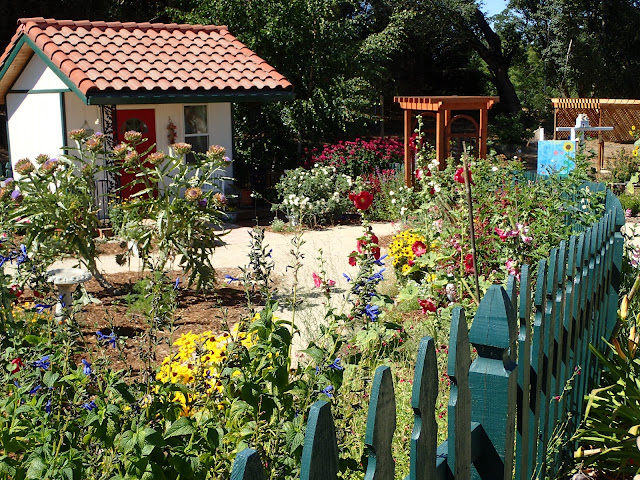
Public can watch master gardeners in action; plant sale April 30

|
| The Cottage Garden is one of 16 areas at the Sherwood Demonstration Garden in Placerville. (Photo courtesy UCCE Master Gardeners of El Dorado County) |
Attention, foothill gardeners: These events are for you!
The UC Cooperative Extension Master Gardeners of El Dorado County close out a busy April with four Open Garden Days plus a big plant sale.
Explore the Master Gardeners’ Sherwood Demonstration Garden, 6699 Campus Drive, Placerville. The garden will welcome visitors from 9 a.m to noon on two consecutive Fridays and Saturdays, April 22 and 23, and April 29 and 30. Admission is free.
“Master Gardeners work hard to maintain this beautiful garden,” say the organizers. “Feel free to stop by to see all of these wonderful plants and learn some new gardening techniques.”
Open Garden Day is just like it sounds; the gates are open to the public as the Master Gardeners tackle their assigned tasks. It’s a great opportunity to ask, “What are you doing?” and “Why?”
Located at the El Dorado Center of Folsom Lake College, the Sherwood Demonstration Garden features 16 themed gardens: All-Stars (water-wise flowering plants), butterfly, children’s, cottage, Japanese, marsh, Mediterranean, natives, orchard, ornamental grasses, perennial, rock, rose, shade, succulents and vegetables.
And takes some plants home, too! On Saturday, April 30, the Master Gardeners will hold a spring ornamental plant sale featuring trees, shrubs, grasses, succulents, native and perennial plants. Sale hours are 8 a.m. to 2 p.m. at the Sherwood Demonstration Garden. Cash, checks, Visa or Mastercard preferred.
For a list of available plants, click here: https://ucanr.edu/sites/EDC_Master_Gardeners/files/366469.pdf
For directions and more details, visit https://mgeldorado.ucanr.edu/ .
Comments
0 comments have been posted.Sacramento Digs Gardening to your inbox.
Food in My Back Yard Series
May 6: Maintain soil moisture with mulch for garden success
April 29: What's (already) wrong with my tomato plants?
April 22: Should you stock up on fertilizer? (Yes!)
April 15: Grow culinary herbs in containers
April 8: When to plant summer vegetables
April 1: Don't be fooled by these garden myths
March 25: Fertilizer tips: How to 'feed' your vegetables for healthy growth
March 18: Time to give vegetable seedlings some more space
March 11: Ways to win the fight against weeds
March 4: Potatoes from the garden
Feb. 25: Plant a fruit tree now -- for later
Feb. 18: How to squeeze more food into less space
Feb. 11: When to plant? Consider staggering your transplants
Feb. 4: Starting in seed starting
Sites We Like
Garden Checklist for week of May 11
Make the most of the lower temperatures early in the week. We’ll be back in the 80s by Thursday.
* Plant, plant, plant! It’s prime planting season in the Sacramento area. Time to set out those tomato transplants along with peppers and eggplants. Pinch off any flowers on new transplants to make them concentrate on establishing roots instead of setting premature fruit.
* Direct-seed melons, cucumbers, summer squash, corn, radishes, pumpkins and annual herbs such as basil.
* Harvest cabbage, lettuce, peas and green onions.
* In the flower garden, direct-seed sunflowers, cosmos, salvia, zinnias, marigolds, celosia and asters. (You also can transplant seedlings for many of the same flowers.)
* Plant dahlia tubers.
* Transplant petunias, marigolds and perennial flowers such as astilbe, columbine, coneflowers, coreopsis, dahlias, rudbeckia and verbena.
* Keep an eye out for slugs, snails, earwigs and aphids that want to dine on tender new growth.
* Feed summer bloomers with a balanced fertilizer.
* For continued bloom, cut off spent flowers on roses as well as other flowering plants.
* Add mulch to the garden to maintain moisture. Mulch also cuts down on weeds. But don’t let it mound around the stems or trunks of trees or shrubs. Leave about a 6-inch-to-1-foot circle to avoid crown rot or other problems.
* Remember to weed! Pull those nasties before they set seed.
* Water early in the day and keep seedlings evenly moist.